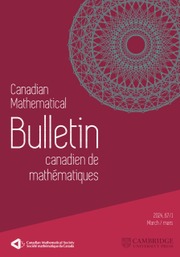No CrossRef data available.
Article contents
Minimal Lagrangian submanifolds of weighted Kim–McCann metrics
Published online by Cambridge University Press: 21 April 2025
Abstract
We explore the regularity theory of optimal transport maps for costs satisfying a Ma–Trudinger–Wang condition, by viewing the graphs of the transport maps as maximal Lagrangian surfaces with respect to an appropriate pseudo-Riemannian metric on the product space. We recover the local regularity theory in two-dimensional manifolds.
Information
- Type
- Article
- Information
- Copyright
- © The Author(s), 2025. Published by Cambridge University Press on behalf of Canadian Mathematical Society
References
Brendle, S., Léger, F., McCann, R. J., and Rankin, C., A geometric approach to apriori estimates for optimal transport maps. J. Reine Angew. Math. 817(2024), 251–266. MR 4834886Google Scholar
Kim, Y.-H. and McCann, R. J.,
Continuity, curvature, and the general covariance of optimal transportation
. J. Eur. Math. Soc. (JEMS) 12(2010), no. 4, 1009–1040. MR 2654086CrossRefGoogle Scholar
Kim, Y.-H., McCann, R. J., and Warren, M.,
Pseudo-Riemannian geometry calibrates optimal transportation
. Math. Res. Lett. 17(2010), no. 6, 1183–1197. MR 2729641CrossRefGoogle Scholar
Loeper, G.,
On the regularity of solutions of optimal transportation problems
. Acta Math. 202(2009), no. 2, 241–283. MR 2506751CrossRefGoogle Scholar
Li, G. and Salavessa, I. M. C.,
Mean curvature flow of spacelike graphs
. Math. Z. 269(2011), nos. 3–4, 697–719. MR 2860260CrossRefGoogle Scholar
Ma, X.-N., Trudinger, N. S., and Wang, X.-J.,
Regularity of potential functions of the optimal transportation problem
. Arch. Ration. Mech. Anal. 177(2005), no. 2, 151–183. MR 2188047CrossRefGoogle Scholar
Warren, M.,
A McLean theorem for the moduli space of Lie solutions to mass transport equations
. Differ. Geom. Appl. 29(2011), no. 6, 816–825. MR 2846278CrossRefGoogle Scholar


